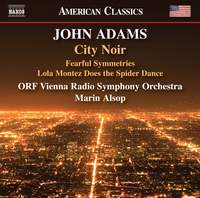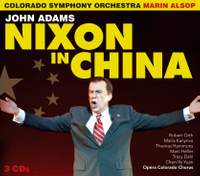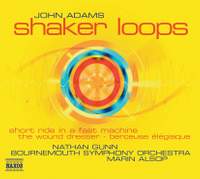Interview,
Marin Alsop on John Adams

American conductor Marin Alsop has long been a champion of the music of compatriot composer John Adams, with previous recordings of his opera, Nixon in China, plus popular works including Shaker Loops and Short Ride in a Fast Machine. Her latest album for Naxos with the ORF Vienna Radio Symphony Orchestra presents a trio of virtuosic orchestral pieces: City Noir, Fearful Symmetries, and the premiere recording of a work dedicated to her and written to mark the end of her twenty-five years as Music Director of the Cabrillo Music Festival, Lola Montez Does the Spider Dance.
I spoke to Marin as she was about to commence rehearsals at the Metropolitan Opera in New York for a production opening later this month of another John Adams opera, El Niño, to talk about her relationship with his music and to discuss the complexities and challenges behind rehearsing and performing the three pieces on the new album.
Can you remember when you first encountered the music of John Adams, and also what you think it is about his compositions that makes them endure in the repertoire of so many orchestras?
I think the first piece of his that I did quite frequently was The Chairman Dances, the short work he excerpted from Nixon in China. I did that a lot early on in my career. It's so quintessentially American, and by that I mean most of his music has an incredible dance groove to it, which to me is a hallmark of American music. And I think also what I was drawn to was that it was minimalism with a sort of Western European structure and architecture.
Coming to the new album, the ORF Vienna Radio Symphony Orchestra under your tenure has become known for doing a broad range of repertoire, but how about John Adams: is he known so much in Europe, and does his music, for want of a better phrase, travel well?
I would say that he's surprisingly popular. Of the twenty-first century American composers he's probably the best known, and I think a lot of that has to do with the fact that he gets a lot of play in London, which has really helped to propel him further south! And the orchestra, they really loved working on his pieces; especially because they're so diverse, you don't feel as though you're playing the same piece three times. They're completely different sound worlds, different concepts, different approaches, everything. It's clearly his voice and his signature, but it doesn't become derivative of itself ever.
Talking about the mood of City Noir to start with, it's so wonderfully evocative. What does that word "noir" mean to you, and how do you think he captures it in this piece?
For me it conjures up the cinema of the 1950s, and this idea of almost an impressionistic view of the narrative underlying those films. So that's what I think of immediately, and it has these wonderful solos that are like individual voices in the night in the city, singing by themselves at two in the morning. We hear all that in the beautiful trumpet and saxophone solos. So it's a very cool piece, and very hard!
You mention how hard the piece is: with such a difficult work and the complexity of the rhythms in particular, how do you begin to learn a score like that and break it down?
I understand John's approach to rhythm, metric modulation, and all that kind of stuff. That's part of his signature, and so as he's building something, and then it suddenly changes from eighth notes into quarter-note triplets, for example, I know where we're heading rhythmically. I have almost a shorthand now with John's music, so it's pretty comfortable for me. And I have to say, this is the kind of challenge that really appeals to me. I know some people prefer maybe more of a harmonic structural challenge, but rhythm is my bag, I love it! So it's always interesting and I guess I dive in with relish, not with fear.
Returning to the mood again, I love the jazzy feel at the start with the vibraphone, solo double bass, and the part for a jazz drummer. Regarding the drummer, I noticed that the score encourages quite free embellishments, leaving it largely to the player to choose the instruments.
That's not really typical of John at all; I think it's much more a reflection of the style that he wanted. He didn't want to dictate, and of course in historic performance practice the drummer would have always added and embellished and filled where he felt it was needed, so John gives him the outline, the tempo, the feel, and then leaves a lot to him, which is nice.
And how much input do you have into that? Or do you just let the player go for it?
I try to balance my tendency toward micromanagement with a good collaborative spirit! But I had a swing band for twenty years, and we had a wonderful drummer in the band. I would talk a lot about different sticks, different strokes, different places on the drum set to play, so I probably get more involved than any drummer would like!
Speaking of rhythms, Fearful Symmetries must be one of his most propulsive pieces. You seem to be something of a champion of it and come back to it quite often. Why do you think it isn't performed more frequently?
It's probably a combination of things. You have to have such a great saxophone quartet, all these samplers, which nowadays are quite tricky to find, and then you have to have an expert in those samplers. So, I'm sure those factors dissuade people from going near it. But I think a lot of people just don't know the piece. The audience loves it, they go crazy for it, because it's a retro piece in a way now; it harkens back to the early days of techno-pop and also to the great big band swing. So it really embraces and embodies a lot of the styles of music that I love so much and I'm so drawn to.
The title comes from the Blake poem The Tyger, but it's nothing to do with that poem thematically, is it?
I think he just liked the phrase! It's so binary in form that it lines up with the symmetry of pop songs: two bars, four bars, that kind of thing. So he's doing a parody of the pop music world.
One of the things that surprised me is that apart from the timpani, all the percussion is sampled, and in the score there's a comment that the written pitches for the keyboard part bear no resemblance to the resulting sounds. Does that create a challenge for you when you're learning it?
I was also struck by that because when I first heard a recording of the piece, I didn't realise that all the percussion was incorporated into the samplers. So it is tricky, trying to get the right sound on the samplers and, when I first learned it, imagining what that sound would be. It's very different when it's sampled as opposed to being played by a percussionist on an instrument that responds right away, and of course a lot of it is very dependent on the skill level of the keyboard player.
The final piece on the album, Lola Montez Does the Spider Dance, is dedicated to you. I'm curious to know how the process works when it's a composer you know very well. Did you have any input into the subject matter? And does he send you ideas when he's working on it, or are you more or less just presented with the final piece?
That's a great question, but actually this was kind of a different situation because it was a bit of a surprise! I decided after twenty-five years that was probably enough at the Cabrillo Music Festival, and so for my final season in 2016, the musicians talked to John about writing a piece for me. It was very emotional and very, very sweet. He was working on his opera, Girls of the Golden West, and so he excerpted this from it; its inspiration and its DNA come from that opera.
When I first heard that it was called "spider dance" I was expecting it to be some sort of tarantella, but he does something so much more interesting than that.
It's just wonderful and crazy. I think he knows that I like a challenge. So even in these four minutes, it's really a tricky little piece.
Obviously he conducts a lot of his own music, but when he's "just" the composer, does he come to rehearsals and make tweaks and suggestions as you go along?
Oh yes: actually with the little piece he wrote for me, he wasn't really happy with the end, and so for this recording, he revised it. So that was kind of nice. He's so in demand as a conductor and composer all over the world, but when possible he would come to my rehearsals, especially in California when I was so close. He would sometimes make changes, with new things here and there, and as a conductor also he has a very good vision of adjusting for the particular hall you're playing in. So he's always super helpful when he comes.
As we speak you're just about to start rehearsals for a production of El Niño at the Metropolitan Opera in New York; do you have any future plans to do more of his works?
I'd love to do any of his operas. I did Nixon in China and recorded it as well for Naxos, and loved the piece. I'm actually bringing Fearful Symmetries to the Concertgebouw in June, and I've got it scheduled quite a bit here and there. City Noir is a difficult piece to take around because it's so hard. You need to know the players in the orchestra and make sure everybody's comfortable with it. But definitely Fearful Symmetries remains my party piece!
ORF Vienna Radio Symphony Orchestra, Marin Alsop
Available Formats: CD, MP3, FLAC, Hi-Res FLAC
Robert Orth, Maria Kanyova, Thomas Hammons, Marc Heller, Tracy Dahl, Chen-Ye Yuan, Melissa Malde, Julie Simson & Jennifer DeDominici, Colorado Symphony Orchestra & Opera Colorado Chorus, Marin Alsop
Available Formats: 3 CDs, MP3, FLAC
Nathan Gunn (baritone), Bournemouth Symphony Orchestra, Marin Alsop
Available Formats: CD, MP3, FLAC





